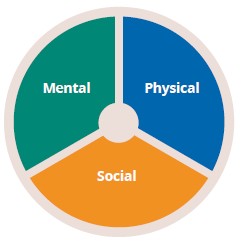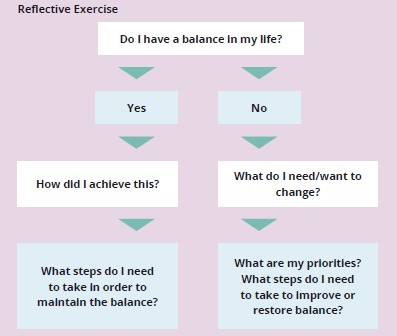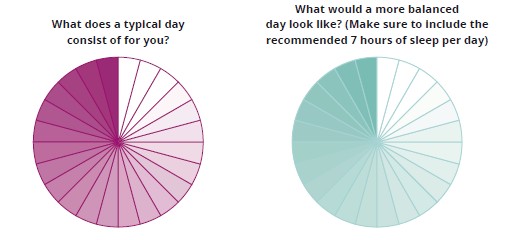Chapter 20 – Karen Mahon (D1SOP20)
Domain 1 Standard of Proficiency 20
Be aware of and be able to take responsibility for managing one’s own health and wellbeing.
|
KEY TERMS Physical wellbeing Mental wellbeing Social wellbeing Responsibility and management
|
Social care is … about empowering and supporting people to achieve their full potential. It includes having an understanding and ability to meet people where they are at, to listen, hear and be their voice when they lose theirs. |
Consider
What does health and wellbeing mean to you?
What does it mean for you to take responsibility in managing your own health and wellbeing?
How do we succeed in achieving this proficiency?
Introduction to Health and Wellbeing
Social care workers are acutely aware of the importance of health and wellbeing; however their focus is often in relation to those we work with or care for. Leading by example is an effective tool in passing on appropriate lifelong skills.
First, we need to understand what the proficiency is asking of us in order to apply this information to improve our own health and wellbeing. In 1948 the World Health Organisation (WHO) defined health as a state of complete physical, mental and social wellbeing, not merely the absence of disease or infirmity (WHO 2020). Using this definition we accept that our physical and mental health are intrinsically linked and we need to strive to achieve a balance of the two. The proficiency also draws our attention to the idea of a life well lived, through creating a balance between the private self and the work self (Keyes 1998). To be proficient is to gain advancement in knowledge or skill (Merriam- Webster), and to better understand the aims and objectives of this proficiency, this chapter looks at all three dimensions of health: mental, physical and social wellbeing.
TASK 1
Draw a circle and divide it into three sections: physical, social and mental. In each section identify the proactive measures you take when striving to achieve a healthy balance. Think about:
All the physical activities you like to do
The positive relationships you have
The rituals you use to create a more positive mood.

Physical Wellbeing
Maslow (1943) identifies our physiological need for food, water, shelter and sleep as basic requirements – these are our basic survival needs. Maslow believes that once these basic needs are met, we then move on to meeting our next need. This does not take away from the complexity of managing our physical health and the need to maintain it. For example, the food choices we make, the quality and amount of sleep we get have a significant impact on how efficiently our bodies are functioning. Monitoring and being aware of this is essential not only for ourselves but also in supporting the people we may work with. The Centers for Disease Control and Prevention (CDC 2020) identify tobacco use, excessive alcohol, lack of physical activity and poor nutrition as the main risk factors in preventable chronic diseases.
While being active has enormous benefits for physical health, the mental health benefits are equally important. Being active helps release chemicals in the brain which have a positive effect on our mood (Health Promotion 2020) – these are often referred to as ‘happiness hormones’.
Case Study 1
CrossFit West Dublin owner Lorna Heyes shares her thoughts on the power of exercise and training:
‘Being active has a ripple effect on our whole lives. When you exercise you are doing something you enjoy which makes you happy. Through the hard work you put into your training you build self-worth and confidence, you begin to look and feel better doing things you never thought possible. Being active will build a resilience inside you that you have never felt before, so when life goes wrong, as it always will at some time, you will be strong enough mentally and physically to handle it. Choosing exercise to reduce stress and anxiety has an incredibly positive effect on our overall health and wellbeing. Exercise is the superpower for mental health, that one hour you choose to move can change your whole life. I know I have seen it happen for thousands of people over the last 15 years.’
Mental Health – Emotional Wellbeing
‘Mental health is defined as a state of wellbeing in which every individual realises his or her own potential, can cope with the normal stresses of life, can work productively and fruitfully, and is able to make a contribution to her or his community’ (WHO 2014: para. 1). Mental health is multifaceted and is not static. It is important to differentiate between mental health and mental illness. Everyone has mental health and current statistics show that one in six people have mental health issues (OECD/ EU 2018). In order to keep ourselves well and functioning at our best we need to take a holistic approach and find a balance.
The importance of self-care cannot be stressed enough; it is crucial that we look after and care for ourselves on a regular basis and not just in response to a sudden crisis.
Mental Health Ireland (MHI 2020) promotes positive mental health. In its campaign Five Ways to Wellbeing it identified five key principles:
- Connect
- Be active
- Take notice
- Keep learning
- Give.
For more detailed information on the campaign please visit the Mental Health Ireland website.
When we talk about balance, we are referring to having a balance between work and life; that feeling of satisfaction we get when we feel balanced. The need to have a purpose in life and to be connected to others is not newly discovered; it heavily influences our sense of self.

Responsibility and Management
It is each individual’s responsibility to take control of and manage their own health and wellbeing. This does not negate the responsibility and onus on employers, lecturers and practice educators to support and encourage the development of social care workers. Social care is a demanding profession and can be driven by the need or desire to help others. It’s important to remember that not everyone seeks or is ready to accept help. In order to manage our health and wellbeing needs we also need to understand and adhere to the policies and procedures that have been put in place for the protection of employees and for the service users.
Supervision is integral in social care and in the personal and professional development of self. The role of a social care worker is varied and can be carried out across a range of services and settings, so it is important to be able to understand one’s self and how that influences one’s practice. Dr Pat Kostouros and Shannon Kearney presented at the 2019 Unity Through Relationships Conference on the need to address compassion fatigue and compassion satisfaction in supervision. The Professional Quality of Life Scale (ProQOL) Compassion Satisfaction and Compassion Fatigue Questionnaire is a useful tool and may be beneficial in providing further insight. Version 5 (2009) is the most recent and is available on the ProQOL website at https://proqol.org/uploads/ProQOL_5_English_Self-Score.pdf.
The more we understand about ourselves the better equipped we are to manage our health and wellbeing. The nature of social care often draws those with lived experience into the field.
Studies are being undertaken to better understand the impact and prevalence of compassion fatigue in various settings. According to the Compassion Fatigue Awareness Project, up to 50% of healthcare workers can experience symptoms. They have similar characteristics, but It is important to be aware of the difference between compassion fatigue and burnout.
TASK 3
In pairs or small groups discuss the following:
- Signs of compassion fatigue and burnout – how do they differ?
- Is it possible to avoid and prevent compassion fatigue?
- How do you address compassion fatigue?
- What are the dangers of not actively addressing the signs and symptoms of compassion fatigue?
How do Social Care Workers Find a Healthy Balance?
It is important to remember that what works for one person does not necessarily work for another. What do I do to ensure I stay grounded and take time to support and encourage self-care? I am a planner, list maker and firm believer in having a soothe kit. A soothe kit is very personal, but there are endless ideas online for putting together your own kit. It is a wellness tool that can be added to on an ongoing basis. It may also be referred to as a wellness kit or tool box.
What belongs in a soothe kit? Here are some ideas:
Items that evoke special memories such as a shell from a trip, concert tickets or a card from someone special.
Reminders to take a break and what to do when taking that break, for example some bubble bath, a teabag, scented candle or a book.
Think about your five senses and choose items that elicit a positive feeling or thought for you, e.g., your favourite perfume, a soft toy, fizzy sweets, photos of family and friends.
I am aware that your own health and wellbeing should be a priority as you cannot provide an adequate service to the best of your abilities for a service user if you are unwell yourself. In order to stay well, I make sure to take care of my physical health by trying to get plenty of sleep, eat healthy food and by exercising. However, it is crucial to remember about your mental health which is equally if not more important than physical health. I do this by trying to stay organised, avoid stress by managing my own workload and trying to achieve the work/college-life balance.’ (Katarzyna, social care student)
‘Reflections: I look out to look in. To ensure I’m happy with my practice to ensure I’m happy in my head. Sometimes it leads to corrections.’ (Elisa, social care worker in ID services)
‘I like to take some time for myself where I don’t think about anything other than the task at hand. When I swim I just think about counting the lengths, when I’m sewing I’m just focusing on making something. It’s like a form of meditation for me.’ (Katrina, social care worker in day services)
‘With the demands and challenges of working with young people presenting with significant mental health difficulties I’m very aware of the need to mind my self-care, mental health and wellbeing. Maintaining wellness is my own personal responsibility. Eating well, getting exercise, prioritising good sleep hygiene are just some of the things I try to do. Managing my workload, seeking support and guidance from my workcolleagues regarding my clinical work is also important. Knowing my triggers and having a plan to manage same as well as engaging in my wellness tools can all help reduce stress and maintain positivity and productivity.’ (Suzanne, social care leader in CAMHS)
TASK 4
Thinking of all you have read in this chapter, take a look at your typical day using a simple circle divided into 24 hours.

Take Note
- Everything in moderation: we’re striving to achieve that balance.
- Manage stress levels: stress is a very real part of daily life and it has both physical and mental manifestations. The more resilient we are, the better able we are to manage inevitable stress. The ‘science of bounceability’ focuses on the ability to adapt to the challenges of work and life (Martin: website).
- Get organised and plan your day: having a sense of purpose to your day, no matter how big or small, can give a feeling of achievement.
- Advocate: social care workers are generally great in advocating for others but sometimes not for themselves. Remember, it is okay to say No and to ask for help when needed.
- Time out: time is precious and it is important to make it for yourself as well as others.
- Take notice: be present in the moment using your five senses to acknowledge and appreciate your surroundings.
References
CDC (Centers for Disease Control and Prevention) (2020) Lack of Physical Activity. Available at: <https://www.cdc.gov/chronicdisease/resources/publications/factsheets/physical-activity.htm> [accessed 30 May 2020].
Compassion Fatigue Awareness Project (2020) Available at: https://www.compassionfatigue.org/index. html (Accessed 21 March 2021).
Health Promotion (2020) Physical Activity. Available at <https://www.healthpromotion.ie/health/ physical_activity> [accessed 30 May 2020].
Keyes, C.L.M (1998) ‘Social well-being’, Social Psychology Quarterly 61(2) (June): 121-40.
Martin, S. (website) Moodwatchers <https://moodwatchers.com/wp/?page_id=2328> [accessed 31 May 2020].
Maslow, A.H. (2013) A Theory of Human Motivation. USA: Wilder Publications.
Merriam-Webster (website), definition of Proficiency. Available at <https://www.merriam-webster.com/ dictionary/proficiency> [accessed 25 April 2020].
MHI (Mental Health Ireland) (2020) Five Ways to Wellbeing. Available at <https://www.mentalhealthireland.ie/five-ways-to-wellbeing/> [accessed 23 May 2020].
OECD/EU (Organisation for Economic Co-operation and Development/European Union) (2018) Health at a Glance: Europe 2018: State of Health in the EU Cycle. Available at <https://doi.org/10.1787/health_ glance_eur-2018-en> [accessed 25 April 2020].
Professional Quality of Life (2009) Compassion Satisfaction and Compassion Fatigue. Available at <https://proqol.org/uploads/ProQOL_5_English_Self-Score.pdf> [accessed 23 May 2020].
WHO (World Health Organisation) (2014) Mental Health: A State of Wellbeing. Available at <http://origin.who.int/features/factfiles/mental_health/en/> [accessed 25 April 2020).
WHO (World Health Organization) (2020) Constitution. Available at <https://www.who.int/about/who-we-are/constitution> [accessed 25 April 2020].

